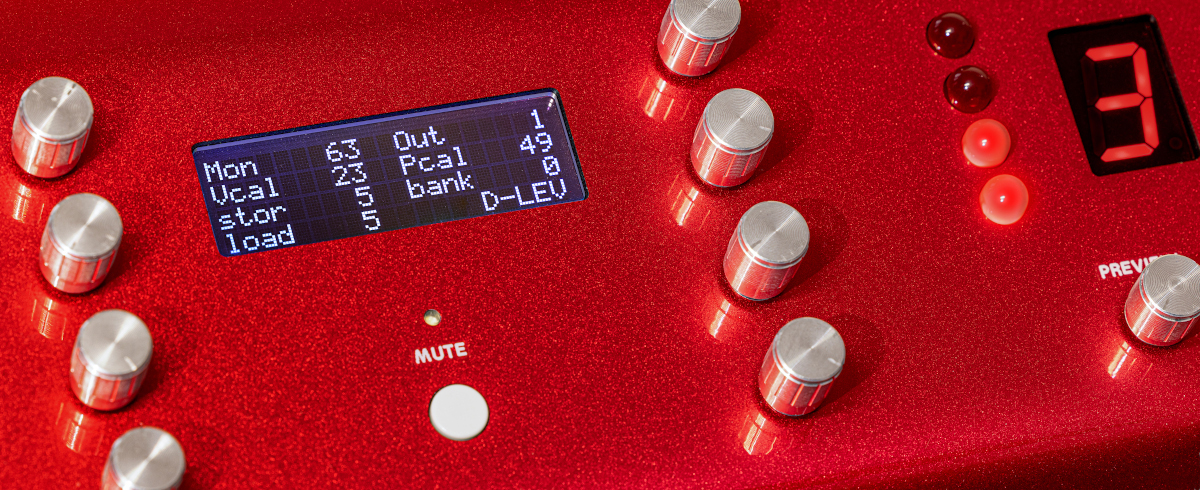
The D-Lev is a (mostly) digital Theremin with many unique features. The primary achievement is the linearity of the pitch and volume fields, which are much more linear than anything you've ever experienced. Field sensitivity can be configured to best suit your playing style, and the volume field has an adjustable knee. True pitch correction, full-featured pitch preview, and real-time visual pitch feedback via the LED "tuner" all provide much welcomed assists to performance.
The synth is sufficient to emulate human vocals, strings, brass, woodwinds, bells, percussion, crazy sounds, etc. The variety of voices encourages the development of different playing techniques, and helps maintain an interest in playing itself. MIDI out lets you control almost any outboard synth for further sonic explorations.
The D-Lev was designed from the ground up using FPGA technology, and incorporates my Hive soft processor core and phase locked peripherals into a highly responsive, tightly integrated whole. Boot time and null calibration are almost instantaneous, so you won't lose any ideas or inspiration waiting to play.
No. A traditional Theremin heterodynes or non-linearly mixes the outputs of two ultrasonic analog oscillators. One oscillator operates at a fixed frequency, and the frequency of the other oscillator varies with the capacitance of the pitch hand. Mixing generates frequency images at F1+F2 and F1-F2, and lowpass filtering removes the upper image, leaving the lower image, which is within the range of human audibility. Even though the frequency of the variable oscillator only changes a few percent over the full range of pitch hand movement, the difference frequency varies over many octaves.
Traditional volume control can take many forms. Similar to the pitch side, the frequency of the volume oscillator varies with the capacitance of the volume hand. One common technique to produce a large change in signal over a relatively short range of hand movement is to sharply filter the oscillator output, rectify and filter it (not shown) and use the result to amplitude modulate the heterodyned pitch side signal.
Note that heterodyning inextricably links the pitch and timbre of the resulting audio, which ties the Theremin designer's hands when it comes to altering the basic (non)linearity, sensitivity, timbre, octave, etc. Quite often a second resonance is employed to improve near-field pitch linearity, but this makes the Theremin much more problematic to keep in proper adjustment. Coupling the fixed and variable oscillators can enrich low end timbre, but this also negatively impacts far-field linearity.
It's amazing that you can make a traditional Theremin that works pretty well with only a handful of parts, but the engineering constraints present at the lowest level will remain almost no matter how fancy any additional circuitry gets. The near and far fields will always be somewhat cramped, and the mid-field will always have the same sensitivity (which I feel is too high).
Yes. Exactly like a traditional analog Theremin, the digital Theremin employs oscillators that vary in frequency with the capacitance of the player's hands. The exact same electrostatic interaction is at work, and the heterodyned frequency difference is replaced by a simple and noiseless arithmetic subtraction. Musicians who are accustomed to traditional analog Theremins won't have to alter their fundamental style or techniques in order to play the D-Lev (unless they want to).
The variable oscillators in the D-Lev are almost entirely digital, which makes them quite stable. Their operating frequencies are therefore just a series of numbers which are fed to an internal DSP (Digital Signal Processing) based music synthesizer in order to produce audio.
Separating hand capacitance sensing from sound generation opens up a new world of exciting possibilities for both the designer and the player. The pitch and volume numbers are extensively digitally filtered to dramatically reduce environmental noise and hum. The responses of the fields are linearized mathematically via a set-and-forget process. The octave and timbre are entirely defined by the synth, with presets to easily switch among a variety of very different voices. In terms of technology and features, the D-Lev is a stand-out amongst Theremins, both past and present.
- Eric Wallin, D-Lev designer